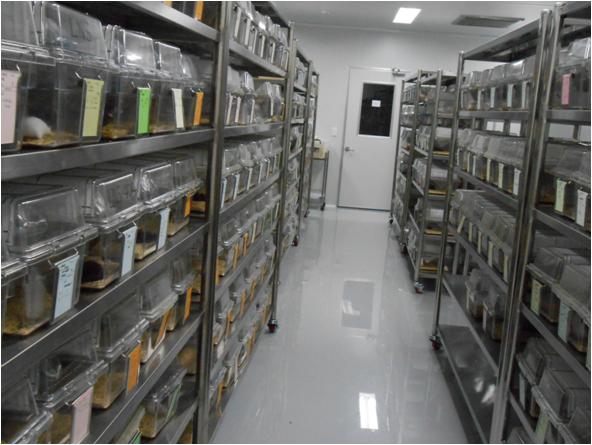Experimental Animal Resource Center
Experimental Animal Resource Center
Overview
Increasingly, many studies undertaken in our school are using animal experiments to explain complex phenomena related to life. To properly manage and supply experimental animals, in 2012 we founded the Experimental Animal Breeding Center under the School of Life Sciences, later affiliated with the College of Life Sciences and Biotechnology. In 2013, it was expanded into the current center to meet the growing demands for animal experiments.
History of Directors
Prof. Se-Ho Park was named first director in 2002 and served for three years, followed by second director Prof. Sang-Ho Lee, who served from 2005 to 2007, and then Prof. Jae-Hong Kim, who took office in October 2007 but resigned shortly thereafter. Prof. Se-Ho Park returned as director in November 2007 and is currently managing the center.
History of Facilities
| Year | Facility Type | Building Status | Location | Capacity (Cages) |
|---|---|---|---|---|
| 2000 | Conventional Laboratory | Newly built | Special Research Sector | 100 |
| 2001 | Specific Pathogen Free (SPF) Laboratory | Newly built | B143, College of Life Science and Biotechnology Building (Nokji) | 700 |
| 2006 | Partial Specific Pathogen Free (SPF) Laboratory | Newly built | 619, College of Life Science and Biotechnology Building (Nokji) |
350 (in use) |
| 2008 | Conventional Laboratory | Remodeled | Special Research Sector | 500 |
| 2010 | Specific Pathogen Free (SPF) Laboratory | Remodeled | B143, College of Life Science and Biotechnology Building (Nokji) |
700 (in use) |
| 2012 | Conventional Laboratory | Newly built/relocated | 133, College of Life Science and Biotechnology Building (Nokji) |
1000 (in use) |
| 2013 | Biosafety Level 2 (BLS2) Laboratory | Relocated | 134, College of Life Science and Biotechnology Building (Nokji) |
50 (in use) |
| 2015 | Conventional/SPF/BSL2 Laboratories | Newly built/relocated | Relocated to Hana Science Building | 6000 |
* 2008 LMO Facility Approved: Specific Pathogen Free (SPF) Laboratory (LML08-329), Conventional Laboratory (LML08-1104)
* 23/04/2010: Registered to the Ministry of Food and Drug Safety as the 193rd animal testing facility under the name of Experimental Animal Breeding Center (Korea University School of Life Science and Biotechnology Building (Nokji))
* 27/05/2013: Facility name registered to the Ministry of Food and Drug Safety changed to Korea University College of Life Science and Biotechnology Experiment Animal Resource Center and re-registered
Facility Management
Before 2007, the animals of each animal facility were cared for directly at the individual laboratory level but since 2008 all animal room facilities have been placed under a unified management. Specialized management by the staff and a system of paying per cage used was established, and is being continued presently.
| Usage Status Quo (Average number of cages used per year) | ||||
|---|---|---|---|---|
| Year | SPF Laboratory | Conventional Laboratory | Total | Number of Laboratories |
| 2008 | 1000 | 250 | 1250 | 19 |
| 2009 | 1020 | 400 | 1420 | 24 |
| 2010 | 880 | 460 | 1340 | 19 |
| 2011 | 770 | 880 | 1650 | 17 |
| 2012 | 800 | 880 | 1680 | 18 |
| 2013 | 960 | 1220 | 2180 | 22 |
| 2014 | 1030 | 1250 | 2280 | 21 |
Facilities Overview
- SPF Animal Room

- Quasi-SPF Animal Room

- Conventional Animal Breeding Room

- Biosafety Level 2 Animal Lab

The center has been operated since 2001 in a space of some 595 m² in the Life Sciences Hall on the green campus to support animal experiments, which are growing in importance in life sciences research. The center is composed of an office (4th floor), the SPF Animal Lab (1st underground floor), Quasi-SPF Animal Lab (6th floor), Non-SPF Animal Room (1st floor), Infected Animal Room (1st floor), Gamma Calibration Room (1st underground floor). Four staff members, not including the director, currently work for the center. As of October 2013, 21 research labs were using 10,000 mice and rats in 2,500 cages.
For researchers’ convenience, we offer cage change services, crossbreeding, separation of baby mice and rats into male and female, and cage removal. Other services include drawing blood, taking tail tissue samples, and attaching animal ID numbers. Moreover, we change the HEPA filters used in clean benches, a service offered at cost if so requested by the lab.
Homepage